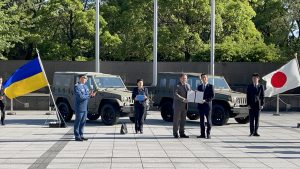The G-7 Hiroshima Summit saw the group of wealthy democracies renew a pledge to defend a rules-based international order and continue military assistance to Ukraine as it keeps fighting against Russia.
While Ukrainian President Volodymyr Zelenskyy was stealing headlines at the G-7 parley, U.S. President Joe Biden and British Prime Minister Rishi Sunak pledged to help train Ukrainian pilots for the U.S.-made F-16 fighter jet. Reversing his previous stance, Biden also authorized U.S. allies to transfer F-16 fighter jets to Kyiv. In addition to this plan, Biden also announced a new $375 million package of military aid to Ukraine that included ammunition and armored vehicles.
Compared to these pledges, Japan’s military support for Ukraine is a drop in the ocean. Tokyo keeps taking baby steps.
In a ceremony held at the Ministry of Defense’s Tokyo headquarters on May 24, Japan handed over two Ground Self-Defense Force (GSDF) transport vehicles to Ukraine. This truck, officially known as the 1/2 Ton Truck, is a six-seat vehicle developed from Mitsubishi Motors’ Pajero. Each vehicle costs about 4.65 million yen ($33,600).
In his meeting with Zelenskyy in Hiroshima, Prime Minister Kishida Fumio pledged that Tokyo will provide about 100 transport vehicles to Ukraine. The ceremony on Wednesday marked the handover of the first batch.
Besides the 1/2 Ton Truck, Japan will also provide high-mobility vehicles (worth 8.75 million yen per vehicle) that can accommodate 10 people, as well as carrier dump trucks (worth 14 million yen per vehicle) being used by the GSDF. Tokyo will also offer about 30,000 emergency food rations to Ukraine.
Under the Self-Defense Forces Law, vehicles used by the SDF cannot be transferred directly for free. So at first the vehicles must be recognized as old items that are no longer in use before being donated abroad.
With other Western nations sending advanced weapons – such as High Mobility Artillery Rocket Systems (HIMARS), precision rockets, and Javelin anti-tank weapons – to embattled Ukraine, Japan’s support appears small.
This is because Tokyo is still bound by the Three Principles on Transfer of Defense Equipment and Technology, which prohibit Japan from exporting lethal weapons to a party in a conflict, except to nations that were involved in their development or production. Thus, Japan’s support has taken other forms; it has contributed funds to the United Nations Development Program (UNDP) to clear landmines, remove debris, and provide generators to Ukraine while providing non-lethal weapons such as bulletproof vests and helmets to Kyiv.
Although the Three Principles were rolled out in 2014, the ban on lethal weapons exports has been essentially unchanged for over 30 years. During the Gulf War, Japan provided a total of $13 billion to the multinational forces of the United States and Europe, but it was criticized as “cash diplomacy” without receiving international recognition at the time. It was a bitter experience for the pacifist nation.
In the U.S. and Europe, there is a sense of crisis that if they do not show a firm stance against aggressor nations like Russia, they may invite yet another act of aggression in the future. In Tokyo, there is also a growing sense of danger that “Ukraine today could be East Asia tomorrow,” as Kishida has repeatedly said in the past year, with China clearly in mind.
Now lawmakers at the ruling Liberal Democratic Party, led by Kishida, are trying to ease rules to authorize the delivery of lethal weapons to Ukraine and other nations. Proponent of the change argue that if Japan doesn’t help Ukraine, the country won’t be able to expect to receive support from partners in Europe in the case of a contingency in the Senkaku/Diaoyu Islands (which are administered by Japan but claimed by China) or Taiwan.
In its National Security Strategy published in December, the Japanese government said it will consider updating the arms export guidelines, calling such transfers a key policy instrument “to provide assistance to countries that are subject to aggression in violation of international law, use of force, or threat of force.”
The tricky thing is that the LDP’s junior coalition partner, Komeito, is reluctant to ease those guidelines. Komeito, which is backed by the nation’s most powerful religious group, Soka Gakkai, has been a pacifist party since its birth.
The LDP is striving to reach an agreement with Komeito this summer. Those discussions will be a major litmus test if Japan is indeed in the process of returning to “a normal nation” just like other G-7 countries in the long run.

































